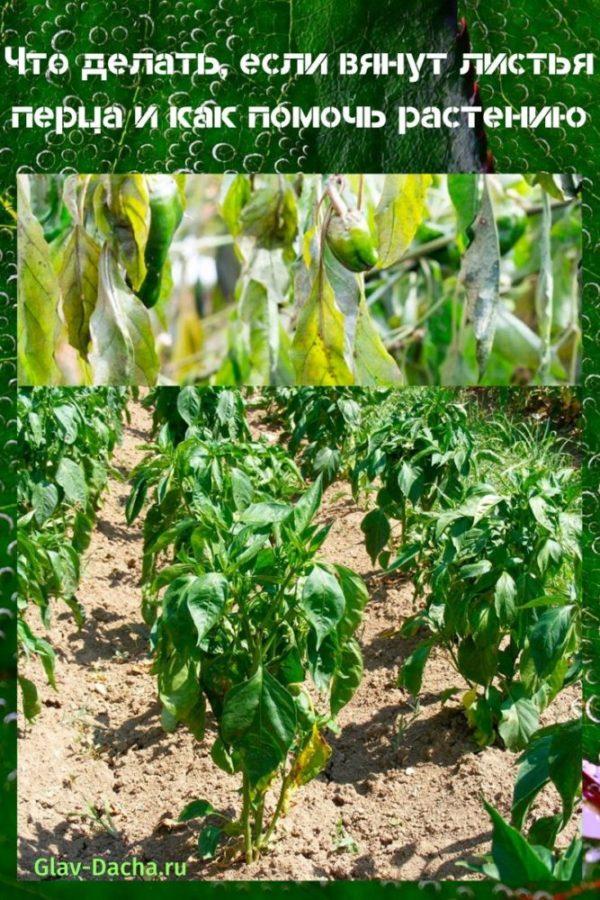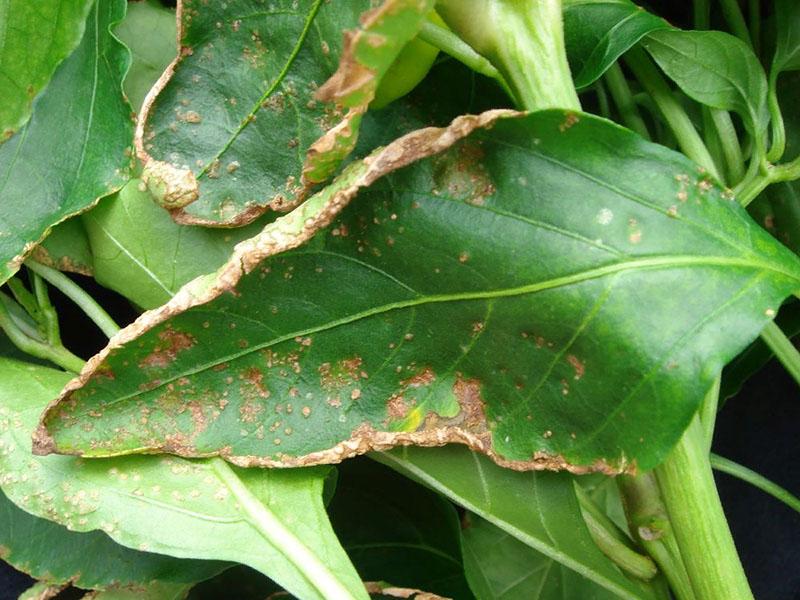What to do if pepper leaves wither and how to help the plant
 Both sweet and hot peppers are grown in our country everywhere, in vegetable gardens and summer cottages. When pepper leaves wither in greenhouses and in beds laid out in the open, the plant's yield drops sharply. Very often the peppers simply disappear completely and the owner is left without a crop. To prevent this from happening, certain measures must be taken.
Both sweet and hot peppers are grown in our country everywhere, in vegetable gardens and summer cottages. When pepper leaves wither in greenhouses and in beds laid out in the open, the plant's yield drops sharply. Very often the peppers simply disappear completely and the owner is left without a crop. To prevent this from happening, certain measures must be taken.

If pepper leaves wither - these are the consequences of nutritional deficiency
 Vegetable crops, like humans, need a balanced diet. Otherwise, their metabolism is disturbed, which can be expressed in a change in appearance. Such plant diseases associated with a lack of components necessary for their development are called non-infectious diseases or severe nutritional deficiencies.
Vegetable crops, like humans, need a balanced diet. Otherwise, their metabolism is disturbed, which can be expressed in a change in appearance. Such plant diseases associated with a lack of components necessary for their development are called non-infectious diseases or severe nutritional deficiencies.
They are often the reasons why the leaves of peppers curl and fall off, and these are also signs:
- weakening the vital activity of pepper;
- decreased immunity;
- an inability to resist bacterial and fungal infections, such as powdery mildew, gray rot, black leg, late blight.
 Plant starvation can be not only total, often a decrease in growth rates causes a lack of only one, but a very important nutrient. If the leaves of pepper wither, it means that metabolic processes change, various anomalies appear. The lack of even one essential substance cannot be compensated for by others.
Plant starvation can be not only total, often a decrease in growth rates causes a lack of only one, but a very important nutrient. If the leaves of pepper wither, it means that metabolic processes change, various anomalies appear. The lack of even one essential substance cannot be compensated for by others.
Lack of potassium
 Pepper plants usually lack potassium if grown in peaty or sandy soils.
Pepper plants usually lack potassium if grown in peaty or sandy soils.
The symptoms of this condition are as follows:
- the lower leaves curl up, acquire a yellowish color, their edges dry out;
- the stems become stiff, their growth stops;
- the fruits are stained.
Potassium deficiency in peppers is most often manifested at the time of fruit formation, therefore, it is necessary to give the plants the opportunity to replenish it as soon as possible.
As an effective preventive measure, complex fertilizers are used, which include not only potassium, but also magnesium and phosphorus. Before planting the seedlings of peppers in the soil, the beds are fertilized with ash obtained from burning deciduous trees. Peppers also respond well to the introduction of ash into the soil in late autumn, when digging a site allotted for this crop.
During the process of growing peppers both in the open field and in greenhouses, the plants should be provided with the necessary trace elements, because their amount in the soil is constantly decreasing. This depends not only on the absorption by the roots of plants, but also on washing out in rainy weather, or during the period of intense melting of the snow cover in the garden beds. Therefore, humus and manure are introduced before planting. And during the growing season, fertilizers are used - ammophoska, nitrophoska, diammofoska.
Pepper leaves wither from the attack of aphids
 Aphid infestation can kill peppers. It is worth carefully examining the plants if the leaves of the peppers wither.First, insects parasitize on the most delicate and young leaves, the tops of the shoots. Then they spread throughout the bush. Provoked by their actions, lack of nutrition negatively affects the leaves, they curl, begin to dry. The ovaries fall off.
Aphid infestation can kill peppers. It is worth carefully examining the plants if the leaves of the peppers wither.First, insects parasitize on the most delicate and young leaves, the tops of the shoots. Then they spread throughout the bush. Provoked by their actions, lack of nutrition negatively affects the leaves, they curl, begin to dry. The ovaries fall off.
Aphid infestation can be caused by:
- hot weather and high humidity;
- contaminated soil.
- the fact that adult flying individuals can lay eggs on the tops of plants.
A sticky mass appears on peppers with aphids, ants run along their stems, and egg clutches are noticeable on the underside of the leaves. Plants must be cleaned of aphids as soon as possible, since these pests are also carriers of infectious diseases.
To get rid of aphids, gardeners often use folk remedies. It can be a solution of laundry soap, infusion of ash, spruce needles, as well as products based on peroxide and ammonia.
Spider mite damage
 You can notice that a pest has appeared on the peppers on the cobweb. Ticks cover their offspring in leaves, for which they roll them up into a tube. With the help of a piercing-sucking mouth apparatus, they suck out cell juice. This prevents the plant from developing normally. The growing larvae feed on plant sap and damage the roots. The peppers gradually weaken, the leaves dry out and fall off, their development stops. They die.
You can notice that a pest has appeared on the peppers on the cobweb. Ticks cover their offspring in leaves, for which they roll them up into a tube. With the help of a piercing-sucking mouth apparatus, they suck out cell juice. This prevents the plant from developing normally. The growing larvae feed on plant sap and damage the roots. The peppers gradually weaken, the leaves dry out and fall off, their development stops. They die.
Depending on the degree of infection, biological, chemical, agrotechnical and other complex means are used. Quite effective are highly specialized ones, represented by acaricides or more universal insectoacaricides, toxin preparations that should be used only during certain periods of plant development.
Why are the leaves of pepper seedlings deformed?
 When growing seedlings on your own, there are often unwanted moments. Even experienced gardeners have young plants that can get sick and even die. To prevent this from happening, you need to monitor the temperature regime in the room, carry out all the necessary feeding. But why do the leaves of peppers wrinkle?
When growing seedlings on your own, there are often unwanted moments. Even experienced gardeners have young plants that can get sick and even die. To prevent this from happening, you need to monitor the temperature regime in the room, carry out all the necessary feeding. But why do the leaves of peppers wrinkle?
The most common cause of leaf curling, as well as shrinkage, is the rapid growth of the midribs, as the blades do not keep up with them. This is usually the case with the top of the peppers. If the leaves are curled at the tops of healthy-looking plants, you should not be scared, they will not affect their growth and yield. After a while, the leaves will return to their normal shape.
Aphids and spider mites are most harmful to seedlings of peppers. These are the most important factors that rapidly impair the development of plants and clearly demonstrate why pepper seedlings wither. Because of pests, all young plants can die if they do not begin to fight when the first twisted leaves are found.
To rid the seedlings of aphids and spider mites, it is not enough to process only the ground part of the plants. We must not forget that their larvae can be in the soil.
If the leaves of the peppers began to curl, use fairly simple means.:
- Potassium permanganate solution. Manganese is diluted very poorly, since you need to water the seedlings with warm light pink water.

- Infusion of onion peels. Add 2 cups of dry onion scales to 2 liters of water. Insist day.

Seedlings are processed until they recover. Between watering, breaks must be taken, lasting at least two or three days.
To make young peppers feel good enough, containers with soil prepared for planting are pre-disinfected. In about two days, the soil boxes are well spilled with very hot water. Then allow the liquid to drain, and the soil to cool completely at room temperature.
To cope with the deficiency of potassium seedlings will help wood ash and potassium nitrate, which is considered one of the most effective remedies. Add 1 tablespoon of fertilizer to 5 liters of water.The solution is poured over the soil, which must be pre-moistened.